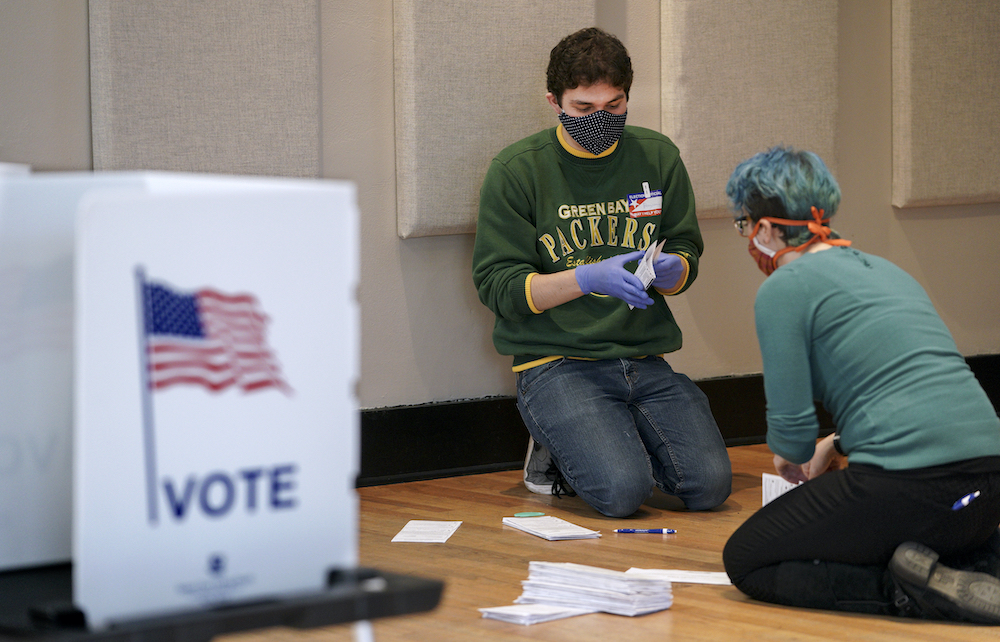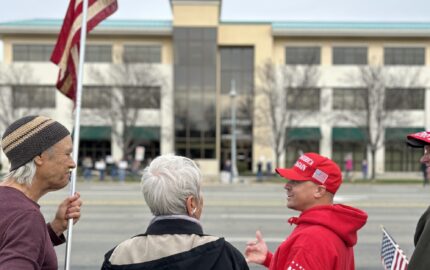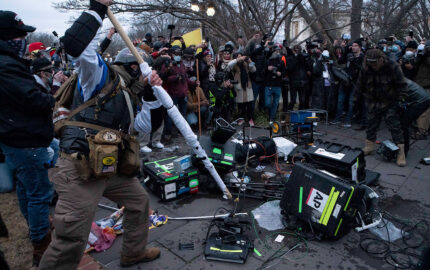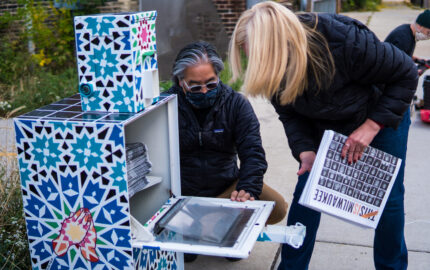In the midst of a deadly pandemic, during a reckoning on race, at a time of deep political division, Americans will elect a president. This has been one of the most uncertain and overwhelming presidential campaigns in modern U.S. history.
It has been an epic, exhausting year for our staff. When the coronavirus reached the Midwest in March, we quickly abandoned our historic newsroom at 4th & State and the building where Lucius Nieman — whose widow, Agnes Nieman, bequeathed to Harvard the funding that led to the creation of the Nieman Foundation for Journalism — had laid the cornerstone nearly a century before. We didn’t know then that we’d never return; the building has been sold, and desks are being moved this week into a bright new space six blocks east in which we’ll eventually regroup.
But in the most important ways we never left. Our work has continued — first covering the coronavirus, the shutdown and all its impacts; the famously “ridiculous” lines outside Milwaukee polling stations when our April election went on as scheduled during the pandemic’s first peak; the lawsuits over elections and ballots and mask mandates that rushed right up to both the Wisconsin and U.S. Supreme courts; the continuing difficulties of people thrown out of work and trying to collect unemployment from an agency using software from another century; the months of nightly protests after George Floyd was killed; the shooting of Jacob Blake by Kenosha Police; the shooting of Kenosha protesters by a 17-year-old armed with an assault rifle; the ouster of Milwaukee’s police chief; a deeply polarized state where 536 municipalities voted for Obama in 2012 and Trump in 2016, perhaps a key state again for whoever will win the Electoral College vote in 2020.
Related Reading
With mis- and disinformation campaigns heating up, a vacancy on the supreme Court, and a President who refuses to commit to accepting the results, the 2020 election arrives at a period of extraordinary uncertainty and tension. Nieman Reports and Nieman Lab are publishing a collection of stories exploring how newsrooms are covering this intensely contested vote and its aftermath.
Reuters: From Covering the Election to the Pandemic, “We Build Trusth When We Are Trustworthy”
By Stephen J. Adler, Nieman Reports
High Voter Turnout? Result Delays? What to Expect from Cable News on Election Night
By Celeste Katz Marston, Nieman Reports
The election could be contested and last for weeks after Nov. 3. Here’s what experts think journalists should know.
By Sarah Scire, Nieman Lab
And now the coronavirus has returned with a vengeance as records are set almost daily in Wisconsin for infections, hospitalizations, ICU patients, and deaths.
I’ve never been part of any team that has worked harder or smarter or better than this one. I’ve never been prouder of our newsroom.
Through it all, we have worked to serve our community, our state, our democracy. We continue to deliver fair, accurate, honest, and thorough reports about the candidates and their positions. We understand that voters will add their own experiences, knowledge, beliefs, and concerns to information they receive from a combination of sources in making their choices. We have a deep respect for this democratic process, for each citizen's participation in selecting our elected representatives.
We cover the campaigns of all leading contenders equally. We get comments from all sides of a story and add relevant context and background that the politicians and their supporters may not provide. We ask them questions our readers ask us.
We seek those questions from the varied communities in our city and state, striving to provide relevant, trustworthy information that informs all the citizens in our democracy. That means reaching out to those who haven't used legacy news organizations like ours as their primary sources of information, listening to their most pressing concerns, and then delivering relevant stories through the platforms they choose, including mobile apps, text alerts, and social networks.
We continue to hold our elected officials accountable for their choices and actions. Despite a daily crush of news like I’ve never seen before over the course of 10 presidential elections, we’ve continued to publish major investigations and in-depth explanatory reports. This includes showing, with great clarity and depth, how the United States had the top-rated pandemic preparedness plan in the world as recently as 2019 — and the “almost inconceivable failure” of the federal government in carrying it out.
We report what those in power say, promise, and do (or don't do) to the people they represent and serve. We do not engage in politics ourselves.
Our journalists guard our news organization's independence from all whom we cover: No yard signs, no bumper stickers, no signing petitions, no political donations, no campaigning for ballot measures or candidates. This independence extends to media appearances and social network posts.
Living in one of the most politically polarized places in swing-state America, we know of no other way to earn the trust of people from all sides than by going where the facts, the evidence, the truth lead us, independent of partisans. But this carries the responsibility of listening to all the people in our community, including those whose voices have not been heard in the past.
We believe all citizens have the right to vote in secret for their government representatives. However, any individual choices and viewpoints of journalists that might cause readers to question our impartiality in news coverage are expected to remain private.
Our newsroom operates PolitiFact Wisconsin, which fact-checks claims regarding Wisconsin politics. We evaluate significant statements rooted in verifiable facts, not expressions of opinion. Reporters examine each evaluated statement on its own merits. We ask the person who made the statement for sources to verify their claims, we seek out independent research, and we include links to all of our sources, so readers can evaluate the material themselves.
To ensure consistency, a team of at least three people trained and experienced in PolitiFact methodology rate each statement against this scale: TRUE – The statement is accurate and there’s nothing significant missing. MOSTLY TRUE – The statement is accurate but needs clarification or additional information. HALF TRUE – The statement is partially accurate but leaves out important details or takes things out of context. MOSTLY FALSE – The statement contains an element of truth but ignores critical facts that would give a different impression. FALSE – The statement is not accurate. PANTS ON FIRE – The statement is not accurate and makes a ridiculous claim.
We play no favorites and pull no punches. You can check Wisconsin political figures on the PolitiFact database and find Republicans, Democrats, and others with ratings across the Truth-O-Meter spectrum. You will never find this kind of equal treatment at a news site that is biased for one side or the other. Our bias is for the truth.
We will provide continuous updates as election results come in on November 3 as well as reports from polling places around Wisconsin. We are buying the most thorough and reliable data available for this key Electoral College state, including in-depth analysis of how many votes remain outstanding, from which districts and the voting patterns of those districts in past elections.
We rely on the Associated Press, a trusted election news service for more than a century, to call races. The AP employs a large team of expert election analysts and researchers on its Decision Desk. AP won't speculate or call any race until it can definitely say a trailing candidate no longer has a path to victory.
On election night we will do everything in our power to keep our readers informed of exactly what is happening. Absentee votes cannot be counted before November 3 in Wisconsin but will continue to be counted through the night.
We saw a preview of what can happen in 2018 when incumbent Governor Scott Walker was running neck-and-neck and sometimes slightly ahead of challenger Tony Evers with nearly all precincts reporting. However, our reporter Craig Gilbert had determined earlier in the evening that, given the high turnout statewide and the apparently high turnout in Milwaukee, the City was reporting a lower vote total than its percent of reporting precincts would suggest. Our reporters called city and county elections officials and learned that absentee votes were not included in the percentage of precincts reporting from Milwaukee County — and would not be added until that day’s in-person vote was tallied.
We immediately began letting the people of Wisconsin know that thousands of legitimate, valid votes from Milwaukee had not been counted yet and that, if they came in at similar percentages as the in-person vote, Evers could jump past Walker. We also explained that representatives of the governor and the Republican party were in the room watching the ballot count to ensure its validity.
Late into the night, as Evers did pass Walker, the disappointed governor briefly lashed out at the sudden appearance of votes in Milwaukee as if something were amiss.
Again, we pointed out that his representatives were in the room, watching the count. The fraud suggestions faded away.
We don’t know what will happen Tuesday and the days that follow. It took until December 13 to know who won the 2000 election. We do know we will report it honestly, accurately, thoroughly, truthfully. No matter what.
George Stanley is the editor of the Milwaukee Journal Sentinel.



